2. 江西师范大学鄱阳湖湿地与流域研究教育部重点实验室, 南昌 330022
塑料工业的发展在给人类社会生产、生活带来便利的同时, 也不断在产生大量的废旧塑料垃圾。20世纪50年代初以来, 人类已经生产了8.3×1010 t塑料, 其中已有6.3×1010 t塑料彻底成为废弃物[1-3]。这些废弃的塑料制品中, 只有9%被回收, 另有12%被焚烧处理, 剩余79%的废弃塑料则深埋在垃圾填埋场或在自然环境中累积[4]。塑料在环境中不易被降解, 经长期的光化学降解、热氧化和生物腐蚀等过程的反复作用, 断裂成粒径较小的塑料颗粒, 当这些微小的塑料颗粒直径小于5 mm即可被定义为微塑料[5-7]。微塑料在环境中广泛存在, “十三五”计划已将海洋微塑料污染作为新型环境问题提出[8]。微塑料在生态环境中易被动物误食, 如被鸟类、爬行动物和鱼类、水生动物等误食, Neves等[9]对26种市售鱼进行检测时发现, 所有的鱼体内均存在微塑料, 且有17种鱼体内不止含有一种微塑料; Cole等[10-11]的研究表明, 浮游动物对微塑料的摄入可以明显改变浮游哲水蚤的取食能力, 长期暴露于聚苯乙烯微塑料下, 浮游哲水蚤的繁殖率会明显下降, 但对其生存没有显著影响; Cauwenberghe等[12]对微塑料在贻贝和牡蛎体内存在的调查显示, 微塑料存在于这两种贝类的软组织中。同时存在于环境中的微塑料会吸附重金属和有机物污染物, 并通过洋流作用迁移扩散, 影响污染物的全球分布[13]。微塑料已成为水体与土壤环境中的新型污染物, 被称为水土环境中的PM2.5。因此, 准确量化微塑料在生态环境中的产生及其被生物同化后的潜在风险正日趋重要[14-15]。
近年来, 国内外关于海洋微塑料污染的研究正日益增多。Zurcher[16]对香港自然海滩做了微塑料的种类、分布和生物毒物效应的研究; 赵世烨[17]对长江河口和东海的海水中的悬浮微型塑料进行了定性和定量分析; 周倩等[18]对中国山东的海滩和沿海海水中微塑料的数量、组成和来源等方面均做了相关调查研究。内陆河流与湖泊作为微塑料进入海洋的重要运输通道, 其沉积物的微塑料污染亦不容忽视[19-21]。目前, 关于内陆河流与湖泊沉积物中微塑料污染的研究仍相对较少, Zhao等[22]曾对椒江、瓯江和闽江河口水体的微塑料进行过定量分析; 但关于鄱阳湖流域微塑料颗粒的具体分布、运移路径及其影响尚处于未知状态。本研究对乐安河-鄱阳湖段的底泥进行取样并监测, 通过探究其底泥中微塑料污染的现状及其来源, 以补充鄱阳湖流域微塑料污染方面的相关研究, 为进一步研究内陆河流与湖泊的微塑料污染及其生态影响提供基础数据与资料。
1 材料与方法 1.1 研究区概况鄱阳湖是我国最大的淡水湖泊, 湖区湿地面积约2 700 km2, 是我国湿地生态系统中生物资源最丰富的地区, 也是我国公布的首批国家重点湿地保护地之一[23]。乐安河是鄱阳湖五大水系之一饶河的主要支流, 发源于婺源县东北部的五龙山脉西南麓, 全长279 km, 流域面积8 456 km2[24]。乐安河上游以德兴市所在区域为主, 主要流经沿岸居民区, 附近居民区垃圾倾倒成了塑料污染的主要来源; 汇入乐安河的主要支流有番溪水、安殷河、槎溪河、建节水、铁罗山水、洎水河和大坞河等, 其中, 大坞河是乐安河的主要支流, 流经亚洲最大的铜矿--德兴铜矿, 全长14 km, 近年来, 由于矿产开采排出的污染物、附近居民区垃圾倾倒等人类活动的影响, 大坞河已成为鄱阳湖典型湿地受污染极其严重的区域[25]。
1.2 样点设置与样品采集2016年12月在乐安河-鄱阳湖段分乐安河上游区、乐安河支流大坞河区和乐安河下游区等3个主要区域、共设置9个典型样点采集实验样品, 同时采用GPS定位, 各样点分别为乐安河上游区的海口镇新桥弃渡口(S1)、曹门村(S2)、太白镇(S3);乐安河支流大坞河区的德兴铜矿生活区(S4)、泗洲镇德兴铜矿中学(S5)、铜矿生产区(S6);乐安河下游区的清家湾(S7)、胡家厂(S8)和龙口(S9)等, 各样点位置如图 1所示。在各采样点随机选取若干个50 cm×50 cm的正方形样方框, 采集河口附近深度约为5 cm的沉积物, 装入采样袋后运回实验室, 置于避光处自然风干处理后备用。
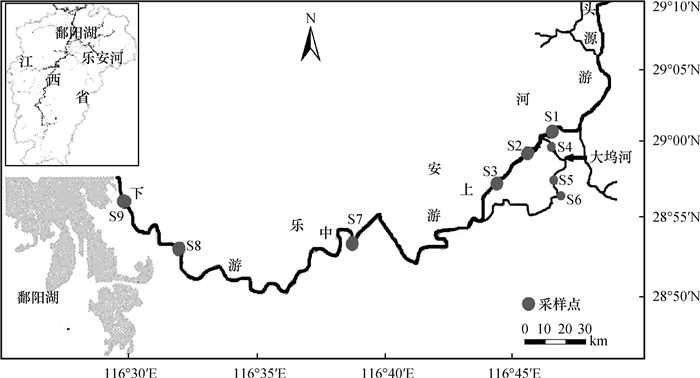
|
图 1 研究区采样点位置图 Fig. 1 Location of the sampling sites in the study area |
对于微塑料的分离, 本实验采用周倩等[18]发明的连续浮选分离装置, 对底泥样品进行连续分离浮选[26], 如图 2所示。首先, 将1 L饱和氯化钠溶液泵入到2 L的烧杯中, 泵入后再向样品杯通入恒定的气流(流速约为1.62 L·min-1)使气体均匀扩散, 气体扩散后加入1 kg样品(干重), 然后再将5 L饱和氯化钠溶液以恒定的流量(约为1.0 L·min-1), 持续泵入样品7中得悬浮液, 使低密度物质随着溢流的悬浮液溢流到溢流收集杯6中; 其次, 采用磁力搅拌方式对溢流收集杯进行搅拌, 使其中的混合液泵入到振动筛中进行湿法筛分, 直至悬浮液充分溢流并湿法筛分至500目振动筛; 最后, 将溢流收集杯内混合液完全转移, 更换浮选液为去离子水清洗液, 用清洗液冲洗溢流收集杯, 并同时将清洗液泵入振动筛中洗去盐基, 用玻璃皿收集振动筛中的残留物。

|
图 2 微塑料连续流动分离浮选装置示意图 Fig. 2 Schematic of the continuous flow separation flotation device for microplastics 1.溶液存储桶, 2.玻璃管, 3.蠕动泵, 4.空气泵, 5.气体流量计, 6.溢流收集杯, 7.样品杯, 8.固定支架, 9.磁力搅拌器, 10.蠕动泵, 11.振动筛, 12.回收槽 |
收集到的残留物中尚残留有部分有机质和泥土, 需进一步浮选分离。先将残留物加入到饱和氯化钠盐溶液中除去泥土, 静置过夜后收集上浮液。将收集好的上浮液也加入到消解液中, 采用65%的HNO3和30%的H2O2(体积比为1︰3)混合液进行消解, 直至消解液体变澄清。待溶液变澄清后加入超纯水, 采用真空抽滤装置抽滤, 收集抽滤后的滤膜(孔径为2 µm)。
1.4 微塑料的鉴定与微观特征分析方法显微鉴定分析方法:将各类分离浮选得到的滤膜置于金相显微镜下(上海精密仪器公司), 观察各类微塑料外观及形态等特征, 采用Nano Measuer 1.2软件计数, 粒径以微塑料最长一边的长度测量[18]。拍照时, 根据所拍摄样品的大小调节显微镜的倍数, 并记录下具体的倍数, 在固定的倍数下对样品的尺寸进行测量, 同时根据照片对样品的颜色和形状进行统计。
电镜扫描-能谱分析方法:将分离好的微塑料颗粒从滤纸上转移至样品台表面固定的双面胶上, 对样品进行喷金处理, 采用扫描电镜(S-3400N, 日本日立电子)-能谱仪, 放大倍数5倍~30 000倍, 加速电压为15 kV, 图像储存像素为640×480, 获得微塑料的扫描电子显微镜图像(SEM)及局部扫描电子显微镜图像(SEM-EDS), 观察微塑料的形貌, 分析微塑料的表面形貌特征及表面附着物[27]。
红外光谱分析方法:取各类型的微塑料, 与60℃下真空干燥的100 mg溴化钾混合, 在玛瑙研钵中研磨, 压片, 置于红外光谱仪(Nicolet 6700, 美国Perkin Elmer公司)傅立叶变换红外光谱仪, 测定样品的红外光谱图(扫描范围400~4 000 cm-1, 扫描次数32次, 分辨率为4 cm-1)[28]。
1.5 数据处理底泥沉积物中微塑料丰度使用“ind·kg-1(干重沉积物)”单位表示, 结果采用Origin 9.0软件进行绘图, 并采用SPSS 20软件分析显著性检验, P < 0.05表示差异具有显著性统计学意义。
2 结果与讨论 2.1 沉积物中微塑料类型及粒径分布通过金相显微镜的鉴定分析发现研究区内存在的微塑料的类型主要有碎片类、薄膜类、纤维类和发泡类等4类, 显微摄像图片如图 3。

|
图 3 底泥沉积物中微塑料类型 Fig. 3 Types of microplastics in sediments a.碎片类Fragments; b.薄膜类Films; c.纤维类Fibers; d.发泡类Foams |
在所有调查样点中, 碎片类微塑料所占比重最高, 占总数的58.3%, 其次是发泡类微塑料, 比重为21.5%, 薄膜类和纤维类分别占到13.8%和6.4%, 4类不同微塑料的颜色和形状如表 1所示。
|
|
表 1 沉积物样品中提取的微塑料类型、颜色、形状及其所占比例 Table 1 Types, colors, and shapes of the microplastics in the soil sample and their ratio |
研究区域内微塑料粒径分布如图 4, 以直径小于1 mm的微塑料为主, 占总数的62.4%, 且随着微塑料粒径增大而微塑料数量减少的趋势, 1~2 mm的微塑料占总数的18.7%, 2~3 mm、3~4 mm和4~5 mm分别占8.7%、6.9%和3.3%, 这种粒径及数量关系与山东沿海区域[18]、长江河口区[19]和新加坡红树林等区域的研究结果是一致的[29]。

|
图 4 研究区不同粒径微塑料百分比 Fig. 4 Percentage chart of microplastics different in particle size in study area |
分别对研究区鄱阳湖-乐安河段上述9个采样点的沉积物进行浮选分离后, 统计得到研究区域内微塑料的平均丰度值为1 800 ind·kg-1, 各样点的丰度值如图 5所示, 其中以德兴铜矿生活区(S4)微塑料丰度最高, 平均丰度值为3 153 ind·kg-1, 德兴中学(S5)和德兴铜矿生产区(S6)也是微塑料丰度较高的样点, 丰度值分别为2 842 ind·kg-1和2 619 ind·kg-1, 微塑料丰度最低的位点为乐安河上游的海口镇(S1), 平均丰度值为842 ind·kg-1。同时, 将9个样点按乐安河上游、乐安河支流(大坞河)、乐安河下游等3个区域进行统计分析, 乐安河支流(大坞河)平均丰度值为2 871 ind·kg-1, 乐安河下游平均丰度值为1 366 ind·kg-1, 乐安河上游平均丰度值为1 121 ind·kg-1。3个区域微塑料平均丰度值由高到低依次为乐安河支流(大坞河)、乐安河下游、乐安河上游, 乐安河支流(大坞河)的微塑料丰度值显著性明显高于乐安河下游和乐安河上游(P < 0.05)。存在差异的原因可能是, 一方面, 由于大坞河处在铜矿生产与生活区, 两岸人口稠密集中, 周边的生活垃圾和工业垃圾排放数量比乐安河上游和下游多, 导致微塑料数量增加; 另一方面, 大坞河作为乐安河的支流, 在矿山开采及地表水冲刷作用小, 使得该区域容易聚集微塑料[30]。乐安河下游的微塑料丰度值显著性明显高于乐安河上游(P < 0.05), 这可能是乐安河上游和大坞河水体的微塑料可以通过水动力交换的原因聚集到乐安河下游, 导致该区域微塑料丰度值高于乐安河上游。
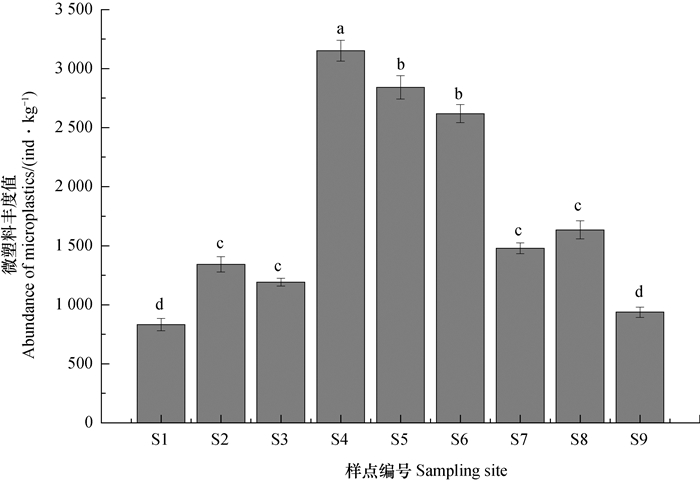
|
图 5 各采样点微塑料丰度值 Fig. 5 Abundance of microplastics in each sampling site |
研究区内9个样点不同类型微塑料组成比例存在一致性和差异性(图 6)。在9个样点中, 碎片类微塑料所占比例均最高, 呈现出一致性。其原因可能是, 一方面, 与碎片类塑料具有更强的脆化性有关, 更易裂解成更小粒径的微塑料, 周倩等[31]认为一个粒径为200 mm的塑料碎片可逐步碎裂成62 500个粒径0.8 mm的微塑料; 另一方面, 乐安河流域两岸除了生活塑料制品以外, 还普遍存在防洪和堆坝所用的工程塑料编织袋及农业生产使用的化肥编织袋等, 这类编织袋在环境中易老化, 造成碎裂并粉化后进入到周围环境及水体中。在发泡类微塑料、薄膜类微塑料和纤维类微塑料所占比例中, 9个样点出现差异性, 例如在胡家厂(S8)样点中, 碎片类微塑料所占比例在9个样点中最低, 发泡类微塑料、薄膜类微塑料和纤维类微塑料相较于其他样点所占比例有所提高, 这是因为采样点周围有渔船停靠, 附近有渔民生活区, 渔船船体发泡塑料浮子和渔线、渔民生活所用的塑料薄膜等生活垃圾来源较多, 导致胡家厂发泡类微塑料、薄膜类微塑料和纤维类微塑料有所提高。因此, 环境中微塑料的组成比例与样地周边的生产生活方式密切相关。
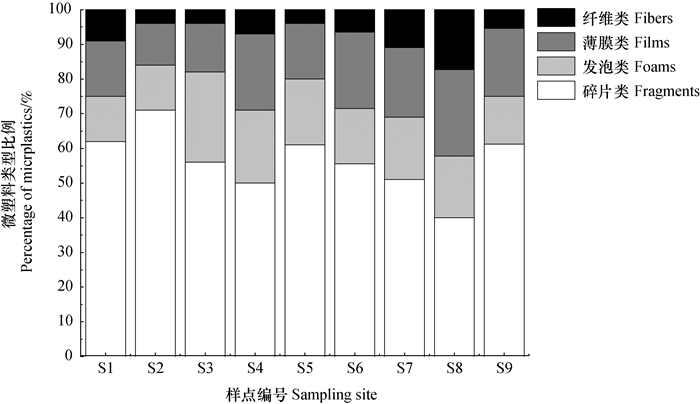
|
图 6 研究区域内微塑料组成比例 Fig. 6 Composition of the microplastic in the research area |
傅里叶变换红外光谱仪能测出样品的化学键, 而不同的化学键能产生特有的光谱, 以碳为主体的聚合物能被检测出。傅里叶变换红外光谱仪有自带的谱库, 不但可以确定样品是否为塑料, 还能确定其聚合物类型。研究区内4种不同类型微塑料的红外光谱分析结果如图 6, 其中碎片类塑料通过红外光谱分析成分主要为聚乙烯(图 7a); 薄膜类微塑料的成分主要为聚丙烯(图 7b); 纤维类微塑料的红外光谱分析成分主要为聚乙烯(图 7c); 发泡类微塑料的成分则主要为聚苯乙烯(图 7d)。将本研究所得红外光谱图与相对应聚合物成分的标准红外光谱图进行对比, 发现二者的聚合物成分虽然均为同一物质, 环境中微塑料的红外光谱波段区的峰要明显多于标准红外光谱图波段区的峰, 这是因为环境中的碎片类在该波段内的峰复杂, 而标准谱图在该波段平整, 几乎无明显的杂峰。
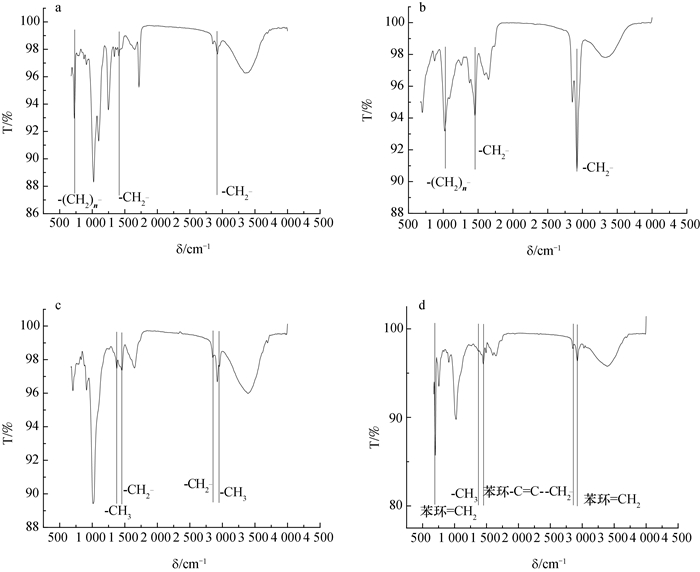
|
图 7 沉积物中不同种类微塑料的红外光谱图 Fig. 7 FTIR spectrum of different microplastics samples in sediments a.碎片类Fragments; b.薄膜类Films; c.纤维类Fibers; d.发泡类Foams |
样品中微塑料具有复杂的表面形貌, 并与其类型有关。图 8中各小图均为对应微塑料的局部表面微观结构。显示碎片类微塑料沿着两端的风化痕迹较明显, 棱角突出、边缘破损程度高(图 8a); 薄膜类微塑料边缘无固定形状且周边边缘破损明显(图 8b); 纤维类微塑料表面凹凸不平, 风化痕迹明显且带有一定的分支(图 8c); 发泡类微塑料表面撕裂程度明显, 带有明显的裂纹(图 8d)。这4种微塑料类型均具有不同类型的微孔特征, 碎片类微塑料纵向撕裂程度明显, 其裂痕长度大于100 µm, 宽度约为5 µm, 裂纹深度结构复杂、粗糙且凸凹不平。Corcoran等[32]认为微塑料表面的微观特征可用于鉴别微塑料表面的易氧化区, 与线性裂纹平行的边缘具有优先氧化的特性; 薄膜类微塑料和纤维类微塑料表面均嵌有丝状残体; 发泡类微塑料表面隆起, 有一定残体且具有孔隙, 显著增加了微塑料的比表面积。总体而言, 底泥环境中的微塑料样品具有表面粗糙、风化程度明显并附带一些残体等特点, 这种变化会导致微塑料比表面积增大, 从而增加对污染物和微生物的吸附能力。Dümichen等[28]和Zhu[33]的研究分别发现环境中微塑料的表面微生物类型和丰度与其表面粗糙程度等有关, 如聚苯乙烯表面微生物群落较多, 硅藻更易附着于具有粗糙表面的微塑料上。
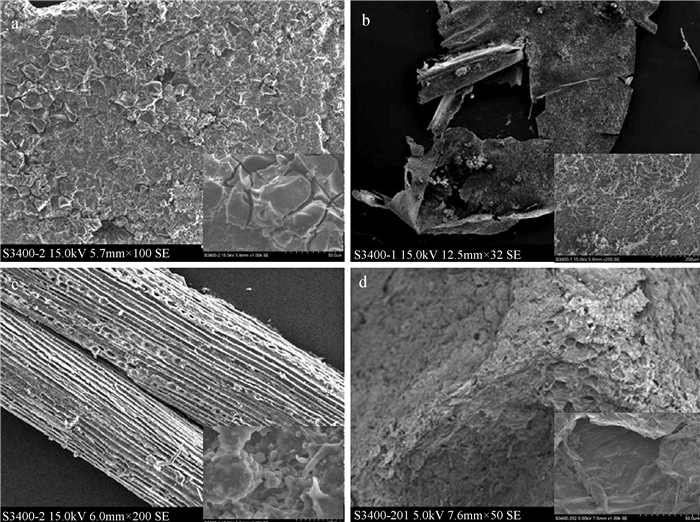
|
图 8 不同类型微塑料的扫描电镜图 Fig. 8 Scanning electron micrographs (SEM) images of the microplastics a.碎片类Fragments; b.薄膜类Films; c.纤维类Fibers; d.发泡类Foams |
环境中微塑料因风化产生的这些多孔表面特性, 会使其表面镶嵌或粘附一些外来物质, 如土壤颗粒、有机物质、微生物和无脊椎动物等等[34], 使得微塑料表面变得更为复杂。本研究通过EDS能谱对微塑料表面的元素组成进行分析, 证实微塑料表面确实粘附了一些外来物质, 结果如图 9。图中显示, 在微塑料表层有Si、Fe、Mg、O、Al、Ca等元素, 其中Si元素主要以氧化物(SiO2)的形态存在, 这表明微塑料的表面附着一些黏土物质, 而Fe、Mg和Al等金属元素均以氧化物的形态存在, 其中铁氧化物在环境中以针铁矿、水铁矿、赤铁矿及无定形铁等多种形态存在。由此可见, 环境中微塑料表面附着物普遍存在且种类多样化, 这些附着物以塑料或微塑料为载体在环境中迁移, 危及生态系统健康。
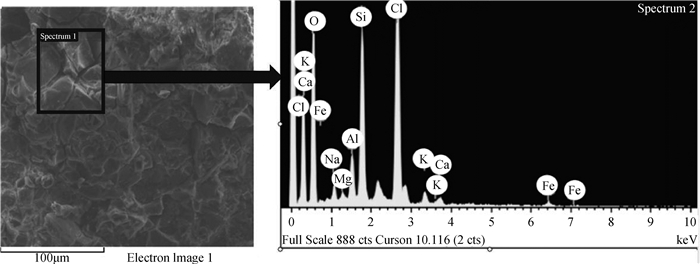
|
图 9 微塑料局部SEM-EDS图 Fig. 9 SEM-EDS images of the microplastics |
乐安河-鄱阳湖段湿地底泥沉积物中主要有4种不同类型的微塑料, 分别为碎片类、发泡类、薄膜类和纤维类, 微塑料平均丰度为1 800 ind·kg-1, 与其他区域的微塑料丰度值相比, 乐安河-鄱阳湖段的微塑料丰度呈中等偏上水平。其中碎片类微塑料的丰度值最高, 约占总数的58.3%, 其次为泡沫类微塑料, 占总数的21.5%, 而发泡类和纤维类微塑料分别占13.8%和6.4%。区内微塑料的粒径以小于1 mm的微塑料为主, 占总数的62.4%, 且随着微塑料粒径的增大, 微塑料的数量呈递减趋势。微塑料主要来源于附近工业污染物排放、附近城市的生活塑料垃圾排放以及渔业活动。底泥样品中分离出来的微塑料表面存在不同程度的风化痕迹, 表面粗糙、撕裂程度明显、且突起一些微塑料残体, 这些特性导致微塑料的比表面积增大, 增加了微塑料对有机污染物、重金属离子和微生物的吸附能力, 能谱分析发现在微塑料表层有Si、Fe、Mg、O、Al、Ca等元素的不同物质形态存在, 进一步加剧微塑料对环境及生物的危害性。
| [1] |
Derraik J G. The pollution of the marine environment by plastic debris:A review . Marine Pollution Bulletin, 2002, 44(9): 842-852. DOI:10.1016/S0025-326X(02)00220-5
(  0) 0) |
| [2] |
Thompson R C, Olsen Y, Mitchell R P, et al. Lost at sea:Where is all the plastic? . Science, 2004, 304(5672): 838. DOI:10.1126/science.1094559
(  0) 0) |
| [3] |
赵淑江, 王海雁, 刘健. 微塑料污染对海洋环境的影响. 海洋科学, 2009, 33(3): 84-86. Zhao S J, Wang H Y, Liu J. Influence of microplastics pollution on marine environment (In Chinese). Marine Sciences, 2009, 33(3): 84-86. (  0) 0) |
| [4] |
Holmes L A, Turner A, Thompson R C. Adsorption of trace metals to plastic resin pellets in the marine environment . Environmental Pollution, 2009, 160(1): 42-48.
(  0) 0) |
| [5] |
Moore C J. Synthetic polymers in the marine environment:A rapidly increasing, long-term threat . Environmental Research, 2008, 108(2): 131-139. DOI:10.1016/j.envres.2008.07.025
(  0) 0) |
| [6] |
Zhou P, Huang C, Fang H, et al. The abundance, composition and sources of marine debris in coastal seawaters or beaches around the northern South China Sea(China) . Marine Pollution Bulletin, 2011, 62(9): 1998-2007. DOI:10.1016/j.marpolbul.2011.06.018
(  0) 0) |
| [7] |
Cózar A, Echevarría F, Gonzálezgordillo J I, et al. Plastic debris in the open ocean . Proceedings of the National Academy of Sciences, 2014, 111(28): 10239-10244. DOI:10.1073/pnas.1314705111
(  0) 0) |
| [8] |
胡卫. 微塑料渗入生态系统危及健康. 橡塑技术与装备, 2017(8): 67-68. Hu W. Microplastics infiltration into the ecosystem and endanger health (In Chinese). China Rubber/Plastics Technology and Equipment, 2017(8): 67-68. (  0) 0) |
| [9] |
Neves D, Sobral P, Ferreira J L, et al. Ingestion of microplastics by commercial fish off the Portuguese coast . Marine Pollution Bulletin, 2015, 101(1): 119-126. DOI:10.1016/j.marpolbul.2015.11.008
(  0) 0) |
| [10] |
Cole M, Lindeque P K, Fileman E, et al. Microplastics alter the properties and sinking rates of zooplankton faecal pellets . Environmental Science & Technology, 2016, 50(6): 3239-3246.
(  0) 0) |
| [11] |
Cole M, Lindeque P, Halsband C, et al. Microplastics as contaminants in the marine environment:A review . Marine Pollution Bulletin, 2011, 62(12): 2588-2597. DOI:10.1016/j.marpolbul.2011.09.025
(  0) 0) |
| [12] |
Cauwenberghe L V, Claessens M, Vandegehuchte M B, et al. Microplastics are taken up by mussels(Mytilus edulis) and lugworms(Arenicola marina) living in natural habitats . Environmental Pollution, 2015, 199: 10-17. DOI:10.1016/j.envpol.2015.01.008
(  0) 0) |
| [13] |
龙邹霞, 余兴光, 金翔龙, 等. 海洋微塑料污染研究进展和问题. 应用海洋学学报, 2017(4): 586-596. Long Z X, Yu X G, Jin X L, et al. Progress in marine microplastics pollution research (In Chinese). Journal of Applied Oceanography, 2017(4): 586-596. DOI:10.3969/J.ISSN.2095-4972.2017.04.017 (  0) 0) |
| [14] |
Fendall L S, Sewell M A. Contributing to marine pollution by washing your face:Microplastics in facial cleansers . Marine Pollution Bulletin, 2009, 58(8): 1225-1228. DOI:10.1016/j.marpolbul.2009.04.025
(  0) 0) |
| [15] |
Fossi M C, Panti C, Guerranti C, et al. Are baleen whales exposed to the threat of microplastics? A case study of the Mediterranean fin whale(Balaenoptera physalus) . Marine Pollution Bulletin, 2012, 64(11): 2374-2379. DOI:10.1016/j.marpolbul.2012.08.013
(  0) 0) |
| [16] |
Zurcher N A. Small plastic debris on beaches in Hong Kong: An initial investigation. Hong Kong: The University of Hong Kong, 2009
(  0) 0) |
| [17] |
赵世烨.中国部分河口微塑料的赋存特征及海洋雪中微塑料分析方法研究.上海: 华东师范大学, 2017 Zhao S Y. Microplastics contamination of some key estaries in China and the approach for analyzing microplastic in marine snow(In Chinese). Shanghai: East China Normal University, 2017 (  0) 0) |
| [18] |
周倩, 章海波, 李远, 等. 海岸环境中微塑料污染及其生态效应研究进展. 科学通报, 2015, 60(33): 3210-3220. Zhou Q, Zhang H B, Li Y, et al. Progress on microplastics pollution and its ecological effects in the coastal environment (In Chinese). Chinese Science Bulletin, 2015, 60(33): 3210-3220. (  0) 0) |
| [19] |
Oliveira M, Ribeiro A, Hylland K, et al. Single and combined effects of microplastics and pyrene on juveniles(0+ group) of the common goby Pomatoschistus microps(Teleostei, Gobiidae) . Ecological Indicators, 2013, 34(11): 641-647.
(  0) 0) |
| [20] |
Zhao S, Zhu L, Teng W, et al. Suspended microplastics in the surface water of the Yangtze Estuary System, China:First observations on occurrence, distribution . Marine Pollution Bulletin, 2014, 86(1/2): 562-568.
(  0) 0) |
| [21] |
Qiu Q, Peng J, Yu X, et al. Occurrence of microplastics in the coastal marine environment:First observation on sediment of China . Marine Pollution Bulletin, 2015, 98(2): 274-280.
(  0) 0) |
| [22] |
Zhao S Y, Zhu L X, Li D J. Microplastic in three urban estuaries, China . Environmental Pollution, 2015, 206: 597-604. DOI:10.1016/j.envpol.2015.08.027
(  0) 0) |
| [23] |
董磊, 徐力刚, 许加星, 等. 鄱阳湖典型洲滩湿地土壤环境因子对植被分布影响研究. 土壤学报, 2014, 51(3): 618-626. Dong L, Xu L G, Xu J X, et al. Effects of soil environmental factors on vegetation distribution in shoaly wetlands typical to Poyang Lake (In Chinese). Acta Pedologica Sinica, 2014, 51(3): 618-626. (  0) 0) |
| [24] |
简敏菲, 李玲玉, 徐鹏飞, 等. 鄱阳湖-乐安河湿地水土环境中重金属污染的时空分布特征. 环境科学, 2014, 35(5): 1759-1765. Jian M F, Li L Y, Xu P F, et al. Spatiotemporal variation characteristics of heavy metals pollution in the water, soil and sediments environment of the Lean River -Poyang Lake wetland (In Chinese). Environmental Science, 2014, 35(5): 1759-1765. (  0) 0) |
| [25] |
陈怀满, 郑春荣, 周东美, 等. 徳兴铜矿尾矿库植被重建后的土壤肥力状况和重金属污染初探. 土壤学报, 2005, 42(1): 29-36. Chen H M, Zheng C R, Zhou D M, et al. Changes in soil fertility and extractable heavy metals in Dexing Copper mine pool after revegetation (In Chinese). Acta Pedologica Sinica, 2005, 42(1): 29-36. DOI:10.3321/j.issn:0564-3929.2005.01.005 (  0) 0) |
| [26] |
简敏菲, 周隆胤, 余厚平, 等. 鄱阳湖-饶河入湖段湿地底泥中微塑料的分离及其表面形貌特征. 环境科学学报, 2018, 38(2): 579-586. Jian M F, Zhou L Y, Yu H P, et al. Separation and microscopic study of microplastics from the sediments of the wetland in the estuary of Raohe River of Poyang Lake (In Chinese). Acta Scientiae Circumstantiae, 2018, 38(2): 579-586. (  0) 0) |
| [27] |
Collard F, Gilbert B, Eppe G, et al. Detection of anthropogenic particles in fish stomachs:An isolation method adapted to identification by Raman spectroscopy . Archives of Environmental Contamination and Toxicology, 2015, 69(3): 331-339. DOI:10.1007/s00244-015-0221-0
(  0) 0) |
| [28] |
Dümichen E, Barthel A K, Braun U, et al. Analysis of polyethylene microplastics in environmental samples, using a thermal decomposition method . Water Research, 2015, 85: 451-457. DOI:10.1016/j.watres.2015.09.002
(  0) 0) |
| [29] |
Eriksen M, Mason S, Wilson S, et al. Microplastic pollution in the surface waters of the Laurentian Great Lakes . Marine Pollution Bulletin, 2013, 77(1/2): 177-182.
(  0) 0) |
| [30] |
Nor N H, Obbard J P. Microplastics in Singapore's coastal mangrove ecosystems . Marine Pollution Bulletin, 2014, 79(1-2): 278-283. DOI:10.1016/j.marpolbul.2013.11.025
(  0) 0) |
| [31] |
周倩, 章海波, 周阳, 等. 滨海潮滩土壤中微塑料的分离及其表面微观特征. 科学通报, 2016, 61(14): 1604-1611. Zhou Q, Zhang H B, Zhou Y, et al. Separation of microplastics from a coastal soil and their surface microscopic features (In Chinese). Chinese Science Bulletin, 2016, 61(14): 1604-1611. (  0) 0) |
| [32] |
Corcoran P L, Biesinger M C, Grifi M. Plastics and beaches:a degrading relationship . Marine Pollution Bulletin, 2009, 58(1): 80-84. DOI:10.1016/j.marpolbul.2008.08.022
(  0) 0) |
| [33] |
Zhu X. Optimization of elutriation device for filtration of microplastic particles from sediment . Marine Pollution Bulletin, 2015, 92(1-2): 69-72. DOI:10.1016/j.marpolbul.2014.12.054
(  0) 0) |
| [34] |
Free C M, Jensen O P, Mason S A, et al. High-levels of microplastic pollution in a large, remote, mountain lake . Marine Pollution Bulletin, 2014, 85(1): 156-163. DOI:10.1016/j.marpolbul.2014.06.001
(  0) 0) |
2. Key Laboratory of Poyang Lake Wetland and Watershed Research(Ministry of Education), Jiangxi Normal University, Nanchang 330022, China
 2018, Vol. 55
2018, Vol. 55


